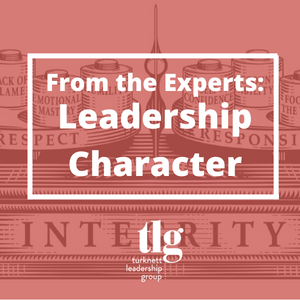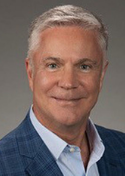
Leadership Character is at the core of everything we do at Turknett Leadership Group. Guided by the Leadership Character Model, we help to develop leaders of character who are grounded in integrity and lead with a balance of respect and responsibility. We asked some of our experts what it means to be a leader of character and to provide an example of someone who led with character in times of crisis.
Answers From the Experts:
 Lyn Turknett, Co-founder and Co-chair, TLG
Lyn Turknett, Co-founder and Co-chair, TLG
When it comes to leadership, what sets leaders of character apart from the rest?
Someone asked recently whether the Leadership Character Model came first or our book – Decent People, Decent Company – came first. The answer is that the model came first, and in thinking about the years in the early 1990’s when my husband and business partner, Bob Turknett, were developing the model, I was reminded what a heady and exciting time that was.
The model, a picture of the character needed to lead, is visualized as a scale with Integrity as the base and Respect and Responsibility balanced on either side. It grew out of that turbulent era when thinking about leadership was being turned on its head. The model has several core premises:
- Leadership is grounded in character – in who you are, not simply what you do.
- Trust is essential for leadership – and integrity is essential for building trust.
- In addition to integrity, leaders of character must balance respect for others with responsibility for results.
- Leadership is a choice – not a position. We can all lead.
Read Lyn’s full article on Leadership Character here.
Crisis Tests Character: What is an example of a business leader who has led with character in times of crisis?
I’ve been thinking a lot about early influences on the Leadership Character Model, and this question made me think of an example of crisis leadership that influenced us profoundly. Bob and I used to regularly attend programs at the Southern Institute of Business and Professional Ethics, founded in 1993 by John Knapp. One of the speakers was a turnaround CEO, and, unfortunately, I can’t remember his name, but he was renowned for his results. And for his integrity. He was clearly an accountable, ethical, hard-working guy.
But what surprised us was his method. He said, “It’s really easy. You just have to be completely honest. Don’t sugarcoat the situation. That builds trust.” He then said that next, in every turnaround situation, he simply asked the employees what to do. He interviewed departments and individuals, and always found that the people in the organization had a clear understanding of the situation and clear ideas about what needed to change. He said that they always appreciated being asked, and were more than willing to roll up their sleeves and help implement the ideas. I am sure that his expertise and experience added to the mix, but he had humility, empathy, and a willingness to learn that was simply remarkable at the time.
We met him before we had created the Leadership Character Model, but, thinking back, he was one of the most remarkable examples we’ve ever met. And he was always leading in crisis.
 Marty Gupta, VP of Strategic Services, TLG
Marty Gupta, VP of Strategic Services, TLG
When it comes to leadership, what sets leaders of character apart from the rest?
First, what do leaders really do and why is leadership character so important? It’s useful to make a distinction between managers and leaders. One of the first to do so was Abraham Zaleznik, a professor at Harvard, who in 1977 published, ‘Managers and Leaders – Are They Different?’, which created an uproar at the time. He argued that managers seek order and control; they focus on process and problem-solving. In contrast, leaders tolerate chaos, ambiguity, and lack of structure as they look for new answers – they are more like artists. Companies need both to succeed.
Ten years later, John Kotter, another Harvard professor, conducted a major study that confirmed and extended this distinction. He found that managers cope with change and leaders create change. Managers plan and budget, organize and staff, and control and problem-solve to produce a degree of predictability and order. In contrast, leaders establish direction, align people to their vision, and motivate and inspire others to produce change – often dramatic change.
Leadership character is imperative to driving organizational change. Setting direction often focuses on longer timeframes, the big picture, managing uncertainty, and people’s values. Winning people over requires honesty and trust as well as empathy and emotional mastery. Aligning people requires integrative thinking (a focus on the whole), getting everyone lined up, and commitment. Motivating and inspiring often focus on empowerment, expansion, and creating the occasional surprise that energizes people. Leaders of character have humility and fierce resolve (Collins, 2001). They view the company and mission above themselves and set high personal expectations. This gives them credibility when making demands of others. All of these are facets of TLG’s Leadership Character Model.
Crisis Tests Character: What is an example of a business leader who has led with character in times of crisis?
Yvon Chouinard, the founder of Patagonia, exemplifies leadership character. Patagonia, now in its 50th year, is known for outdoor clothing and environmental activism. The company has donated 1% of revenues (or 10% of profits, whichever is greater) to environmental groups since 1985. The company was one of the first to offer flexible work hours (‘we don’t care when you work, as long as the work gets done’) and extensive employee benefits (onsite nurseries). Patagonia encourages its customers to repair and reuse its products. Used clothing in good condition can be returned for credit and is then auctioned on its ‘Worn Wear’ website.
Chouinard, a long-time advocate for environmental conservation, believes the earth is in crisis. Last month he announced that he and his family were giving all equity in the company to a charitable entity focused on addressing climate change and protecting undeveloped lands around the world. Each year, the money Patagonia makes after reinvesting in the business will be distributed to the non-profit. The structure was designed to avoid selling the company or taking it public, which could have meant a change in its values.
 Tim Huff, Vice President of Leadership, TLG
Tim Huff, Vice President of Leadership, TLG
When it comes to leadership, what sets leaders of character apart from the rest?
We at TLG say that leadership is a choice, not a position. Adding to that, the degree to which one follows a leader can also be a choice. People can choose to buy into a leader and give 100% effort to the team or they can choose to not buy into the leader and give only a bare minimum effort. The effectiveness of the leader is measured in large part by how the members of the team follow the leader and put forth a maximum effort to deliver superior results.
Several studies have shown that what people want from their leaders is honesty, or by extension, integrity. Integrity is at the heart of leadership character. The essence of leaders of character is that they are grounded in integrity and able to artfully balance respect for others and responsibility to the organization. Leaders who consistently demonstrate integrity and maintain an appropriate balance of respect and responsibility are the leaders who can have people buy into their leadership and give their all for the team’s success. Leaders who don’t demonstrate these essential elements of character might be able to seek out success in the short term but will eventually lose the confidence and respect of their team members and fail.
Crisis Tests Character: What is an example of a business leader who has led with character in times of crisis?
I was fortunate to work for a medical supply and distribution company during the heart of the pandemic, one of the global leading suppliers of surgical-grade personal protective equipment. Needless to say, demand for our products far exceeded our manufacturing capacity in the early months of the pandemic. During this time, it would have been possible for the leaders in our organization to take advantage of the supply imbalance and charge exceedingly high costs for our products to the hospitals and medical professionals around the world who desperately needed the products. Fortunately, our company’s values, which were consistently lived out daily, started with integrity. The company’s leadership made it very clear that we were not going to take advantage of the situation by artificially increasing the price, but we would charge reasonable rates, driven by the market. The company stuck by this decision, even during one memorable situation in which a customer offered to pay double the market rate. The company’s leadership, demonstrating leadership character, earned respect and loyalty from our customers by practicing integrity throughout the pandemic crisis.
 Barbara Reilly, Ph.D., Senior Consultant, TLG
Barbara Reilly, Ph.D., Senior Consultant, TLG
When it comes to leadership, what sets leaders of character apart from the rest?
The concept of balancing respect and responsibility is so important. Leaders of character strive for this balance. We’ve all met or worked for leaders who are tilted one way or the other. Someone who is very focused on responsibility may be all about the task and getting things done. They can come across as robotic though if they lack respect. The Leadership Character Model is a grounding framework in my life and for leaders today.
I have a colleague who reached out to me via email one time with a problem and as I started to type my response, I realized I was unable to get the tone right or properly convey empathy for this specific situation. I needed more understanding of the situation, so I decided that had to be a phone call. It is creating that balance that says ‘yes emails are expedient and get things off my plate and onto yours, but in this case, it deserves a phone call.’ It’s striking that balance of ‘when do you send an email and pick up the phone’ or, ‘when do I pick up the phone versus when I need to meet in-person?’ When do I say this is a business meeting and when is it just having lunch and being able to talk about life? That’s the gift of leadership character and having that balance.
 Bill Dickinson, D. Min, RCC, Senior Consultant, TLG
Bill Dickinson, D. Min, RCC, Senior Consultant, TLG
When it comes to leadership, what sets leaders of character apart from the rest?
We live in a complex and frequently divisive world. And “stuff” comes at us whether at home or at work. In other words, both hardships and hurtful words can get in the way of safeguarding if not elevating human dignity. Leaders of character, in part, honor and promote the innate dignity of others. We understand that diversity of thought, beliefs, and experiences are part and parcel of the human condition. We do not have to embrace or agree with any one value set or lived experience; but leaders of character know, and act accordingly, that others possess self-worth that is beyond us. In short, leaders of character respect, challenge, and develop the potential as well as the best in others. And, all the while why facilitating trust, modeling respect, and protecting the wellbeing of others.
 Brad Parcells, Senior Consultant, TLG
Brad Parcells, Senior Consultant, TLG
When it comes to leadership, what sets leaders of character apart from the rest?
Three characteristics separate good leaders from the great:
- First, great leaders are purposeful and visionary (task-driven competency).
- Second, they know how to foster team play (relating-driven competency) in equal measures.
- Lastly, they lead with courageous authenticity and integrity.
Explore the rest of our team!

